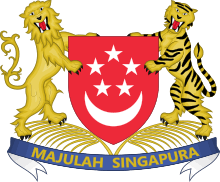Music of Singapore
The music of Singapore has reflected the diverse influences that have shaped the country. Its various communities have their own distinct musical traditions: the Chinese people form the largest ethnic group in Singapore, with Malays, Indians, and smaller number of other peoples of different ethnicity as well as Eurasians.[1] The different people with their traditional forms of music, the various modern musical styles, and the fusion of different forms account for the musical diversity in the country.
| Part of a series on the |
| Culture of Singapore |
|---|
 |
| History |
| Topics |
|
| Research |
| Symbols |
|
It has an urban musical scene, and is a center for pop, rock, punk and other genres in the region. The country has produced in the 1960s bands like The Crescendos and The Quests, right up to the new millennium with pop singers such as Stefanie Sun and JJ Lin. Folk music of Singapore includes the ethnic music traditions of the Chinese, Malay and Tamil communities. Singapore also has a lively Western classical music scene.
Popular music
Singapore has been a regional centre of music industry for a long time. Recordings of Chinese and Malay popular music were done at the EMI studio in Singapore in the colonial period, but until the 1960s, recordings were sent to be pressed in India and the records then sent back for sale.[2] It was a centre of Malay popular culture where Malay stars such as P. Ramlee were based, but after Singapore independence in 1965, the Malay music industry began to shift to Kuala Lumpur.[3]
In the 1960s, local bands in Singapore were inspired by Western groups such as Blue Diamonds, Cliff Richard & the Shadows, and The Beatles. Popular groups of the period included The Crescendos who performed in English with hit songs like "Mr Twister", The Quests who had hits like "Shanty", "Don't Play That Song", "Jesamine" and "Mr Rainbow", as well as other pop-rock bands including The Thunderbirds, The Trailers, The Crescendos, The Western Union Band, October Cherries and The Silver Strings. A Malay genre influenced by British rock and pop called Pop Yeh-Yeh emerged in the 1960s.[4][5] The bands performed in the Malay language, although some may also performed in English or were instrumental. Malay pop bands of the 1960s included Naomi & the Boys who produced a household hit song "Happy Happy Birthday Baby", D'4 Ever, Antarctics, Mike Ibrahim & the Nite Walkers, Swallows, Ismail Haron & the Guys, and Les Kafila's. In the late 1970s and early 1980s saw the rise of rock bands such as Sweet Charity fronted by the vocalist Ramli Sarip.[6] The band had such an influence in the Singapore and Malaysia music scene that it later led to a rock explosion in the mid 1980s.

Singapore also emerged as a centre of local Chinese recording industry in the 1960s, producing Chinese pop music in Mandarin with local singers.[7] From the 60s to the 80s, local stars such as Chang Siao Ying (張小英), Sakura Teng (樱花), Rita Chao (凌雲), and Lena Lim (林竹君) were popular in Singapore and Malaysia.[7] A few, such as Lena Lim, also had some success outside the region.
The pop music industry thrived by the 1980s, with several recording companies producing Chinese records by local as well as Taiwanese singers. Starting in the mid 1980s, a genre of Mandarin ballads called xinyao began to emerge with singers and/or songwriters such as Liang Wern Fook, Lee Shih Shiong, and Billy Koh.[8][9] Local music labels such as Ocean Butterflies International and Hype Records were established. From the 1990s onwards, many Singaporean singers such as Kit Chan, Stefanie Sun, JJ Lin, Tanya Chua, Corrinne May, Fann Wong, and Mavis Hee had achieved wider success outside of Singapore.
There are also a number artists from Singapore who work primarily in the English language, some such as singer-songwriter Sophie Koh are active outside of Singapore. In the 2010s, Singapore has seen a rise in home-grown acts like Charlie Lim, The Sam Willows, Gentle Bones, The Steve McQueens, Pleasantry, MYRNE, HubbaBubbas, Sam Rui, Leon Markcus, Scarlet Avenue and Nathan Hartono.
Ethnic traditions
Chinese
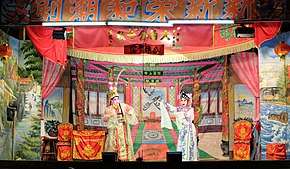
There are speakers of various dialects amongst the Chinese population, such as Hokkien, Hakka, Cantonese, and Teochew, and different dialect speakers may have their own clan associations which support their respective forms of opera. Opera troupes were first formed by amateur music clubs; the earliest amateur music club in Singapore is the Er Woo Amateur Music & Dramatic Association (馀娱儒乐社) set up in 1912 by Teochew businessmen, initially to promote music of the Hakkas (Hanju opera and Handiao music), later also Teochew opera.[10] A number of recordings of Hanju opera performed by Er Woo were made in the 1920s and 1930s. Many professional and amateur opera troupes that performed in various dialects were later established.[11] These opera troupes typically perform during festivals and national events, and may also hold regular small-scale performances, or large-scale ones annually or biannually.[12] The professional troupes may also perform in opera theatres.[13] During Chinese festivities there was also a minstrel tradition called zouchang (walk-sing), which involves walking performance by members of the operatic troupes. In the past, makeshift stages often appeared during festivities along the streets where operas may be performed. However, operas have declined as popular entertainment in the latter half of the 20th century; opera theatres closed, and street opera have mostly been replaced by getai where modern songs and comedy routines are performed,[1] although street opera is still performed by professional and amateur opera troupes.[13]
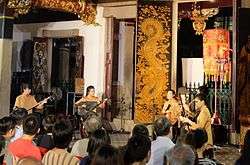
There are many full-sized Chinese orchestras in Singapore. The first Chinese orchestra was formed in 1959 by the Thau Yong Amateur Musical Association (陶融儒乐社), which was established in 1931 by former members of Er Woo.[10] The Singapore Chinese Orchestra is the only professional Chinese orchestra in Singapore,[14] however amateur Chinese orchestras formed by clan associations, community centres and schools are common.[15] There are also chamber ensembles such as those of the Nanguan tradition from Siong Leng Musical Association.[16] Drumming performances which accompany the traditional Lion Dance are also popular.
Malay
Music genres popular in neighbouring Malaysia and Indonesia, such as Dondang Sayang and Keroncong, were also popular among Malays in Singapore. Vocal performances accompanied by kompang and hadrah drums are among the most popular types of Malay music in Singapore, and may be performed during weddings and official functions. Other vocal genres such as dikir barat and ghazal are also popular.[1] An old tradition of Malay opera called Bangsawan existed since the 19th century but had declined, although there are modern attempts at reviving the genre.[17]
Indian
Hindustani and Karnatic music are two forms of Indian classical music that may be found in Singapore. Other forms of music that are popular are Bhajan and Bhangra music,[1] and professional Bhangra troupes may perform at festivities and special events.
Peranakan
The Peranakans are descendants of early Chinese immigrants who had intermarried with the local Malay population, and had adopted, partly or fully, Malay customs. Their folk music is noted for its fusion of English in Malay-inspired tunes, largely because the Peranakans themselves are often conversant in both languages. Contemporary tunes continue to be composed based on the Peranakan culture, such as "Bunga Sayang" composed in 1994,[18] a theme song from Dick Lee's musical "Kampung Amber". The song became an often-sung staple of the National Day Parade, and gained international exposure when it was performed for the opening ceremony of the 117th IOC Session at the Esplanade.
Western classical music
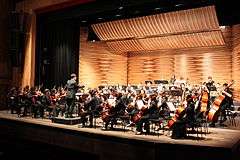
Western classical music plays a significant role in the cultural life in Singapore, and at its center is the Singapore Symphony Orchestra (SSO) which was instituted in 1979. The main performance venue for the orchestra is the Esplanade Concert Hall, but it also performs in Victoria Concert Hall and gives the occasional free performances in parks.[19] Other notable orchestras in Singapore include Singapore National Youth Orchestra which is funded by the Ministry of Education,[20] the community-based Braddell Heights Symphony Orchestra,[21] The Philharmonic Orchestra,[22] Orchestra of the Music Makers, and National University of Singapore Symphony Orchestra.[23] Many orchestras and ensembles are also found in secondary schools and junior colleges.[24]
There are a few opera companies that present Western operas in Singapore: Singapore Lyric Opera which was founded in 1991,[25] and New Opera Singapore established in 2011. There is also a lively local chamber music scene, which took off in 2007. A number of significant changes in the early 2000s boosted the development of the classical music scene in Singapore, in particular the building of the performing arts venue Esplanade - Theatres on the Bay, and the establishment of the first conservatory of Singapore, Yong Siew Toh Conservatory of Music.[24]
Well-known classical musicians from Singapore include Lynnette Seah, Lim Soon Lee, Siow Lee Chin, and Abigail Sin. Some, such as conductor Darrell Ang and Vanessa-Mae, are expat working overseas, there are however an increasing number of local musicians who are actively involved in the classical music scene of Singapore.[24] Some of these classical musicians have ventured into other genres and taken their music to public places, such as the Lorong Boys, who sometimes perform in MRT trains.
Rock music
Alternative and indie rock music influenced bands in the 1990s such as Concave Scream, Humpback Oak, The Padres, Oddfellows, and Livionia. In the Pop/Rock genres were "KICK!", Lizard's Convention & Radio Active.
Recently, alternative, metal, grindcore, punk rock and rock acts from Singapore who gained some profile outside Singapore include Analog Girl, Amateur Takes Control, Cockpit, John Klass, Firebrands, Stompin' Ground, Ling Kai, Inch Chua, Ronin, Anna Judge April, Electrico, Force Vomit, The Observatory, 4-Sides, Vermillion, West Grand Boulevard, Plainsunset, Etc., sub:shaman, Caracal, Popland, The Great Spy Experiment, Sky In Euphoria, Rancour, Saw Loser (formerly known as Pug Jelly), Malex, A Vacant Affair, For Better Endings, Death Metal and Rudra, who are significant for creating the genre "Vedic Metal".
Metal
Metal has a small but not insignificant presence in Singapore's music scene. Many metal bands such as Iron Maiden, Exodus, Morbid Angel, Slayer, Dream Theater and Helloween made Singapore a stop in their tour, at venues such as Fort Canning Park and Singapore Indoor Stadium. Small to medium scale gigs are held almost weekly at locations such as BlackHole212 or The Substation. Most recently, on 15 February 2011, Iron Maiden played to a crowd of 12,000 at the Singapore Indoor Stadium.
There have also been many notable local metal bands from many varying subgenres in the growing underground scene. Special mention includes:
- Black metal stalwarts Impiety,
- Extreme Metal veterans Rudra who created a new metal genre called Vedic Metal and a cult following worldwide. The band has also attracted the attention of Musicologists. Several papers have been published about Vedic Metal and the band,[26]
- Bastardized: Pioneer Doom Melodic Death metal band existing since 1993. "With Love, With Hate, With Grief, With Pain." EP released under Valentine Sound Productions 1994. Poetry styled album "The Over Burdened" expected release in 2016.
- Funeral Hearse signed by prominent American Metal Label Redefining Darkness Records, owned by Thomas Haywood of Aborted and Abigail Williams fame.
- Wormrot has recently been signed by UK record label, Earache Records.[27]
- Local Death Metal "Assault" band new album "The Fallen Reich" features current Taiwan member of Parliament & "ChthoniC" Frontman Freddy Lim and Maldive metal band "Nothnegal" Guitarist Fufu.
There is however little support for metal in Singapore's mainstream media. The heavy metal scene in Singapore therefore has established its own ways of disseminating information by utilizing popular internet based social mediums such as Facebook, Twitter and blogs.
Some Metal music of this generation may be featured occasionally on Brader Bo's show, Vicious Volume of RIA 89.7fm.
Experimental/Improvised
Two Singapore rock bands of the 1970s and 1980s, Heritage and Zircon Lounge, showed tendencies to create music beyond conventional rock idioms. In the late 1980s, Corporate Toil baited audiences with noisy electronic performances influenced by industrial/new wave bands like Suicide or Einstürzende Neubauten. In the 1990s, Kelvin Tan produced literally dozens of albums of avant folk and improvised guitar, as well as assembling the short-lived Stigmata featuring bassist Ian Woo and saxophonist Kelvin Guoh. Zai Kuning, largely known as a visual artist and dancer, lived for a period in Japan and collaborated musically with Tetsu Saitoh, a famed Japanese cellist. Zai also created his own form of Malay folk and gypsy blues music, singing incantations in his deep tenor while playing a loose form of open tuning guitar.
By the late 1990s and into the 2000s, a group of experimental laptop artists appeared: George Chua, Yuen Chee Wai, Evan Tan, Ang Song Ming, and Chong Li-Chuan, the last having received the bachelor's and master's degrees in music at Goldsmiths College, University of London. Straddling the world of digital effects and acoustic instruments was the duo aspidistrafly, who eventually gained an enormous following in Japan, producing their own music and running their kitchen.label. The Observatory, a supergroup formed from the ashes of Leslie Low's folk rock Humpback Oak trio, have been widely regarded as one of the best bands in Singapore, with Yeow Kai Chai of The Straits Times writing, "No other Singapore band, past or present, has captured the imagination quite like The Observatory."[28] With every album, The Observatory have pushed at the limits of the song form, incorporating prog rock, jazz, avant garde guitar, drones, black metal, and more.
Musical outsiders Engineered Beautiful Blood (Shark Fung and Wei Nan) blazed a hot trail of no wave improvised rock, then stopped playing in 2009. However, their members eventually formed a larger improvised rock ensemble, I\D, which itself would splinter off into smaller groups and configurations. Shark Fung himself has been a key figure in the musical margins, with his idiosyncratic solo drums-and-electronics noise outfit Awk Wah, and forming the collective structured improv group BALBALAB with Wu Jun Han, Dennis Tan and Zai Tang in late 2014. Around the middle of the 2000s, another grouping calling themselves Under the Velvet Sky wowed audiences with their performances that evoked prog rock, free jazz, traditional Malay and Chinese music, and more. Again, the loose nature of the collective enabled them to create other projects such as Gulayu Arkestra, Five Leaves Left and Cactus - not to mention the solo efforts of members Jordan Johari Rais and Imran Abdul Rashid.
The Flux_Us store at Peninsular Plaza, opened and run by the Singapore Sonic Arts Community, was an important space for a good two to three years around 2005–2007.[29] Besides stocking local experimental music releases, they also imported CDs and records from international labels like Fonal, Rune Grammofon, Paw Tracks, Sublime Frequencies, Kranky, and more, being practically the only retailer where one could find such music. They also organised in-store gigs featuring local and international artists such as Lucas Abela. Above all the store provided a physical space for like-minded musicians and fans to meet and share ideas.
The influence of an expatriate community cannot be ignored. Lindsay Vickery (Aus), Tim O'Dwyer[30] (Aus), Darren Moore[31] (Aus), Brian O'Reilly[32] (US) and Dirk Johan Stromberg[33] (US) all at some point associated with the music programmes at LASALLE College of the Arts, were involved in organising showcases and festivals of experimental and improvised music. Their interaction and collaboration with local players energised the local experimental music community.
Since 2010, Ujikaji[34] was established as a do-it-yourself experimental music label, distro and event organiser. It has released albums by Magus, Dream State Vision, and Awk Wah. It has been a partner of The Observatory in the innovative Playfreely series of improvised music events.
Music venues
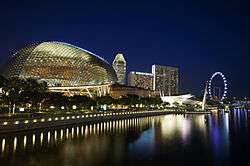
The most important venue for concert is the Esplanade, which replaced Victoria Theatre and Concert Hall as the primary concert hall of Singapore. The Singapore Conference Hall is used as a base for the Singapore Chinese Orchestra.[35] There are also many clubs and music bars that offer live music in the city, particularly in the Clarke Quay area.[36]
The Esplanade
In 2002, Esplanade - Theatres on the Bay, which is the de facto national performing arts centre of Singapore, was launched.[37] It focuses on the island's multi-genre music making, and is now the venue for the Singapore Symphony Orchestra's subscription and gala concerts. In addition, the arts centre has ensured a representation of classical and traditional music from the four primary cultures in the land. In particular, the regular festivals of Hua Yi, Pesta Raya and Kalaa Utsavam ensure that interpreters of these different repertories are heard on a regular basis.
The Esplanade - Theatres on the Bay also presents 3 music festivals, including Baybeats which aims to groom the local alternative music scene and youth culture, providing opportunities for youths and the music community to participate and enjoy their own music at low cost. Many ticketed as well as non-ticketed performances at the Esplanade feature local musicians from Singapore.
Music education
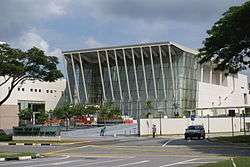
In Singapore, General Music Programme is offered to all students in primary and secondary schools.[38] The Enhanced Music Programme, started in 2011, is offered as an upper secondary programme in selected schools.[39] Tertiary music education is also available in Singapore – the Yong Siew Toh Conservatory of Music, which received its first student intake in 2003,[40] is the first to offer a four-year full-time Bachelor of Music degree programme.[24] The conservatory is part of the National University of Singapore founded in partnership with the Peabody Conservatory, and it serves as a centre of training for young musicians in the Asia Pacific region with full scholarship provided.[41][42]
Music education is also offered at other institutions such as Nanyang Academy of Fine Arts, LASALLE College of the Arts, Raffles Music College and the School of the Arts.[24]
National Day songs
 Life in Singapore |
|---|
Of particular note to the Singaporean music scene is what are often collectively known as National Day Songs (国庆主题歌). Written as part of Singapore's nation-building efforts, they either incorporate local folk songs (such as "Chan Mali Chan"), contemporary songs ("The Magic Is You"), or are specifically composed around a particular theme for the National Day Parade which is held every year on August 9. The tradition of a National Day Song started in the 1980s, although there may not be a song every year, for example in 2014 when older songs were reprised.[43]
In 1984, "Stand Up for Singapore" was initially created for the sole purpose of celebrating Singapore's achievements in 25 years of self-government. Commissioned by the Ministry of Culture and composed by Hugh Harrison, the song struck a chord with Singaporeans, especially when they heard it performed by the New York Philharmonic Orchestra, and so the first 'official' National Day Song was born. The government, realizing just how much the public enjoyed singing as a way of celebrating, commissioned a new song for 1986. As a result, "Count On Me, Singapore", also composed by Hugh Harrison, arranged by Jeremy Monteiro and performed by Clement Chow, became the 2nd 'official' National Day Song. The trend continued the next year, 1987, with "We Are Singapore", again composed by Hugh Harrison and arranged by Jeremy Monteiro. "We Are Singapore" was used again in 2018 with some changes.[44] Then, in 1990 with the addition of "One People, One Nation, One Singapore" composed by Jeremy Monteiro with lyrics by Jim Aitchison for the nation's Silver Jubilee - 25 years of independence, the list of 'official' National Day Songs topped out at four.
Since 1998, National Day Songs have become less 'grandiose' and more popular in nature being composed for and sung by selected local artists and sometimes even included in their albums to be marketed overseas.
- 1998: "Home" (家), by Kit Chan
- 1999: "Together" (心连心), by Evelyn Tan and Dreamz FM
- 2000: "Shine on Me" (星月), by Jai (English version) and Mavis Hee (Mandarin version)
- 2001: "Where I Belong" (属于), by Tanya Chua
- 2002: "We Will Get There" (一起走到), by Stefanie Sun
- 2003: "One United People" (全心全意), by Stefanie Sun
- 2004: "Home" (家), remixed version by JJ Lin, Kit Chan
- 2005: "Reach Out For The Skies" (勇敢向前飞), a duet by Taufik Batisah and Rui En, composed by Elaine Chan. (The Chinese version is sung by Rui En only).
- 2006: "My Island Home" (幸福的图形), by Kaira Gong
- 2007: "There's No Place I'd Rather Be", by Kit Chan (陈洁仪) and Will you - Various Local Artiste
- 2008: "Shine for Singapore" (晴空万里), by Hady Mirza (English version) and Joi Chua (Mandarin version)
- 2009: "What Do You See" (就在这里), by Electrico (English version) and Kelvin Tan (Mandarin version)
- 2010: "Song for Singapore", by Corrinne May[45]
- 2011: "In a Heartbeat", by Sylvia Ratonel
- 2012: "Love At First Light", by Olivia Ong & Natanya Tan
- 2013: "One Singapore", by Sing A Nation Choir[43]
- 2014: Reprise of older songs, such as the 2002 song "We Will Get There" by Farisha Ishak and Tay Ke Wei
- 2015: "Our Singapore", by JJ Lin
- 2016: "Tomorrow's Here Today" by 53A
- 2017: "Because It's Singapore" by Jay Lim
- 2018: "We Are Singapore" (revamp of the 1987's NDP song)[44]
- 2019: "Our Singapore", by various artists
Other community-building songs:
- 2005: "Sing Our Wishes" - Also used as official song for Ministry of Education schools for Racial Harmony Day 2005
- 2005: "We Can"
An ad-hoc offshoot of these National Day Songs are the songs specially composed for groundbreaking events. A prominent example was the song Moments of Magic, written by Hype Records CEO Ken Lim specially for Singapore's millennium celebrations towards the end of 1999. It was performed by three notable singers - Fann Wong, Tanya Chua and Elsa Lin. The music video was directed by Singapore filmmaker Eric Khoo.
- 1999: "Moments of Magic", by Fann Wong, Tanya Chua and Elsa Lin
References
- Lee Tong Soon (2008). "Singapore". In Terry Miller; Sean Williams (eds.). The Garland Handbook of Southeast Asian Music. Routledge. ISBN 978-0-415-96075-5.
- Craig A. Lockard (1998). Dance of Life: Popular Music and Politics in Southeast Asia. University of Hawai'i Press. pp. 217–218. ISBN 978-0-8248-1918-7.
- Craig A. Lockard (1998). Dance of Life: Popular Music and Politics in Southeast Asia. University of Hawai'i Press. p. 220. ISBN 978-0-8248-1918-7.
- Tom Schnabel (March 26, 2013). "Pop Yeh Yeh, 1960s Music from Singapore and Malaysia". PRI's The World. Archived from the original on 2013-06-28. Retrieved 2013-10-08.
- "Melayu Pop Yeh Yeh 60an Swallows with Andy". Singapore 60s Andy's Pop Music Influence. April 29, 2009. Archived from the original on 2014-03-26. Retrieved 2013-10-08.
- World and Its Peoples: Malaysia, Philippines, Singapore, and Brunei. Marshall Cavendish Corporation. 2007. p. 1281. ISBN 9780761476429.
- Craig A. Lockard (1998). Dance of Life: Popular Music and Politics in Southeast Asia. University of Hawai'i Press. pp. 224–228. ISBN 978-0-8248-1918-7.
- Boon Chan (3 August 2013). "Xinyao uniquely Singapore". The Straits Times. Archived from the original on 12 August 2013.
- "An Introduction to Xinyao". Xinyao Singapore. Archived from the original on 2013-10-02. Retrieved 2013-09-27.
- Frederick Lau (2007). Music in China. Oxford University Press. pp. 149–151. ISBN 978-0-19-530124-3.
- Tong Soon Lee (2008). Chinese Street Opera in Singapore. University of Illinois Press. p. 80. ISBN 978-0-252-03246-2.
- Tong Soon Lee (2008). Chinese Street Opera in Singapore. University of Illinois Press. pp. 85–88. ISBN 978-0-252-03246-2.
- Tong Soon Lee (2007). Chinese Street Opera in Singapore. University of Illinois Press. pp. 8–10. ISBN 978-0252032462.
- "Singapore Chinese Orchestra (SCO)". Web Archive Singapore. National Library Board Singapore. Archived from the original on 2011-09-01. Retrieved 2009-03-16.
- "Acclaimed orchestra maestro lives, breathes Chinese music". The Straits Times. 7 August 2013. Archived from the original on 28 September 2013. Retrieved 26 September 2013.
- Koh Sze Wei (May 30, 2006). "Nan Yin – A Historical Perspective". Archived from the original on 2013-10-03. Retrieved 2013-09-26.
- Norman Cho. "Bangsawan In Singapore". Bukit Brown. Archived from the original on 2014-11-09. Retrieved 2014-11-09.
- World and Its Peoples: Eastern and Southern Asia, Volume 9. Cavendish Square Publishing. 2007. p. 1281. ISBN 978-0761476429.
- The Rough Guide to Singapore. Rough Guides. 2003. pp. 155–156. ISBN 9781843530756.
- "Singapore National Youth Orchestra". Ministry of Education. Archived from the original on 2014-10-09. Retrieved 2014-10-05.
- Steven Ang. "Music director Adrian Tan ushers in new era for Braddell Heights Symphony Orchestra". Time Out Singapore. Archived from the original on 2014-10-06. Retrieved 2014-10-05.
- "About Us". The Philharmonic Orchestra Singapore. Archived from the original on 2014-10-06. Retrieved 2014-10-05.
- "NUS Symphony Orchestra". National University of Singapore. Archived from the original on 2014-09-03. Retrieved 2014-10-05.
- Paige Lim (June 11, 2015). "Musicians who lead in the classical scene". The Straits Times. Archived from the original on 2016-01-05. Retrieved 2015-10-19.
- Living in Singapore (14th ed.). Faris Digital Solutions Pte Ltd. 11 July 2016. ISBN 9789813179981.
- Eugene Dairianathan. "'Vedic metal' : a discussion of global and local identity in the practice of extreme metal in the South-Indian community in Singapore" (PDF). Repository.nie.edu.sg. Archived from the original (PDF) on 2012-03-10. Retrieved 2015-10-22.
- "Earache Records signs Wormrot". The Gauntlet. 27 January 2010. Archived from the original on 2010-01-30. Retrieved 2010-06-08.
- Yeow Kai Chai (26 August 2005). "Writing's on the Walls". The Straits Times. Page 10. Retrieved 18 August 2014.
- Gwee, Karen. "The Story of FluxUs: How a Short-Lived Record Store Influenced Singaporean Experimental Music". Bandcamp Daily. Retrieved 6 February 2020.
- "Dr Timothy O'Dwyer". LASALLE College of the Arts. Retrieved 6 February 2020.
- "Dr Darren Moore". LASALLE College of the Arts. Retrieved 6 February 2020.
- "Brian O'Reilly". LASALLE College of the Arts. Retrieved 6 February 2020.
- "Dirk Johan Stromberg". LASALLE College of the Arts. Retrieved 6 February 2020.
- "Ujikaji". Ujikaji. Bandcamp. Retrieved 6 February 2020.
- hermes (2017-07-20). "Singapore Conference Hall to get big revamp". The Straits Times. Archived from the original on 2018-11-14. Retrieved 2018-11-14.
- Mat Oakle (2008). Singapore Encounter. Lonely Planet Publications. pp. 79–81. ISBN 978-1741048841.
- "Esplanade the National Performing Arts Centre". Ghetto Singapore. Archived from the original on 2015-08-19. Retrieved 18 August 2015.
- "2015 Syllabus General Music Programme" (PDF). Ministry of Education Singapore. Archived from the original (PDF) on 2015-03-19.
- "Enhanced Music Programme". Ministry of Education. Archived from the original on 2016-09-27. Retrieved 2016-09-24.
- hermes (2016-05-24). "NUS music school strikes the right note". The Straits Times. Archived from the original on 2016-07-30. Retrieved 2018-11-14.
- Patricia Shehan Campbell; Trevor Wiggins, eds. (2013). The Oxford Handbook of Children's Musical Cultures, Volume 2. Oxford University Press. p. 344. ISBN 978-0199737635.
- Robert Markow (September 2005). "Failure is not an Option". The Strad. Archived from the original on 2015-12-22.
- Royston Sim (May 15, 2014). "No new National Day song for this year's parade". The Straits Times. Archived from the original on 2016-09-21. Retrieved 2016-08-13.
- Keng Yang Shuen (23 May 2018). "The NDP 2018 song is out, and it's a little surprising". Asia One.
- "Get ready for bigger, bolder, grander NDP". Asiaone. Archived from the original on 2017-10-29. Retrieved 2016-08-13.
